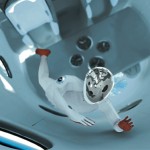
Scientists from the University of Bonn in Germany have solved a mystery that has bothered palaeontologists for years. Discoveries have been made in many places around the world of dinosaur teeth preserved in neat rows, even though they had no jawbones to hold them in place while in the ground for millions of years. Something must have held them there, and according to the German scientists, for the big herbivorous dinosaurs known as sauropods, that something was a beak.
The scientists studied teeth rows from several sauropods, including Camarasaurus, of which entire skulls have been discovered. Camarasaurus lived some 150 million years ago, growing
up to 23 metres long and weighing up to 45 tonnes.
The studies showed that signs of wear were typically visible only halfway down the teeth from the tooth points. The rest, down to where the teeth met the jaw, was protected in a beak-like structure made of keratin – the material from which bird beaks (and our own hair) are formed. The jawbone of Camarsaurus included small hollows that might have carried blood vessels to supply the beak tissue with nutrients. The beak probably protected and stabilised the teeth while the huge animals consumed ductile plants such as ferns and branches with needles.






